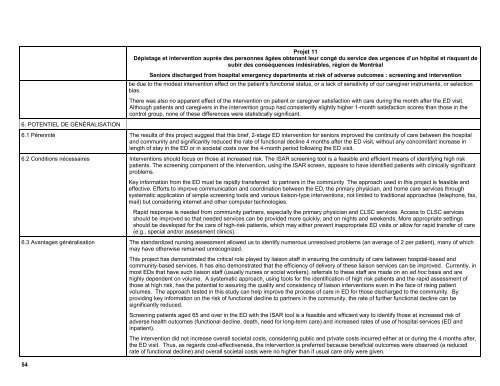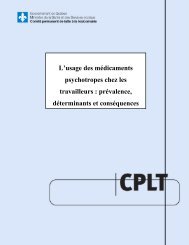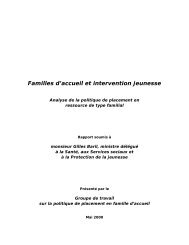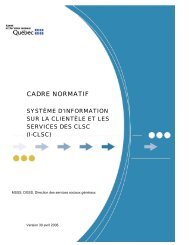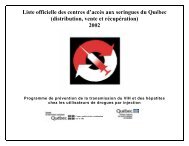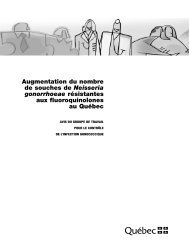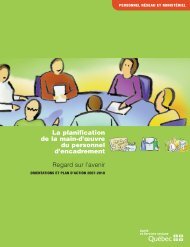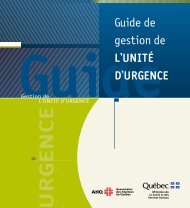De l'innovation au changement - Gouvernement du Québec
De l'innovation au changement - Gouvernement du Québec
De l'innovation au changement - Gouvernement du Québec
Create successful ePaper yourself
Turn your PDF publications into a flip-book with our unique Google optimized e-Paper software.
6. POTENTIEL DE GÉNÉRALISATION<br />
54<br />
Projet 11<br />
Dépistage et intervention <strong>au</strong>près des personnes âgées obtenant leur congé <strong>du</strong> service des urgences d’un hôpital et risquant de<br />
subir des conséquences indésirables, région de Montréal<br />
Seniors discharged from hospital emergency departments at risk of adverse outcomes : screening and intervention<br />
be <strong>du</strong>e to the modest intervention effect on the patient’s functional status, or a lack of sensitivity of our caregiver instruments, or selection<br />
bias.<br />
There was also no apparent effect of the intervention on patient or caregiver satisfaction with care <strong>du</strong>ring the month after the ED visit.<br />
Although patients and caregivers in the intervention group had consistently slightly higher 1-month satisfaction scores than those in the<br />
control group, none of these differences were statistically significant.<br />
6.1 Pérennité The results of this project suggest that this brief, 2-stage ED intervention for seniors improved the continuity of care between the hospital<br />
and community and significantly re<strong>du</strong>ced the rate of functional decline 4 months after the ED visit, without any concomitant increase in<br />
length of stay in the ED or in societal costs over the 4-month period following the ED visit.<br />
6.2 Conditions nécessaires Interventions should focus on those at increased risk. The ISAR screening tool is a feasible and efficient means of identifying high risk<br />
patients. The screening component of the intervention, using the ISAR screen, appears to have identified patients with clinically significant<br />
problems.<br />
Key information from the ED must be rapidly transferred to partners in the community The approach used in this project is feasible and<br />
effective. Efforts to improve communication and coordination between the ED, the primary physician, and home care services through<br />
systematic application of simple screening tools and various liaison-type interventions, not limited to traditional approaches (telephone, fax,<br />
mail) but considering internet and other computer technologies.<br />
Rapid response is needed from community partners, especially the primary physician and CLSC services. Access to CLSC services<br />
should be improved so that needed services can be provided more quickly, and on nights and weekends. More appropriate settings<br />
should be developed for the care of high-risk patients, which may either prevent inappropriate ED visits or allow for rapid transfer of care<br />
(e.g., special and/or assessment clinics).<br />
6.3 Avantages généralisation The standardized nursing assessment allowed us to identify numerous unresolved problems (an average of 2 per patient), many of which<br />
may have otherwise remained unrecognized.<br />
This project has demonstrated the critical role played by liaison staff in ensuring the continuity of care between hospital-based and<br />
community-based services. It has also demonstrated that the efficiency of delivery of these liaison services can be improved. Currently, in<br />
most EDs that have such liaison staff (usually nurses or social workers), referrals to these staff are made on an ad hoc basis and are<br />
highly dependent on volume. A systematic approach, using tools for the identification of high risk patients and the rapid assessment of<br />
those at high risk, has the potential to assuring the quality and consistency of liaison interventions even in the face of rising patient<br />
volumes. The approach tested in this study can help improve the process of care in ED for those discharged to the community. By<br />
providing key information on the risk of functional decline to partners in the community, the rate of further functional decline can be<br />
significantly re<strong>du</strong>ced.<br />
Screening patients aged 65 and over in the ED with the ISAR tool is a feasible and efficient way to identify those at increased risk of<br />
adverse health outcomes (functional decline, death, need for long-term care) and increased rates of use of hospital services (ED and<br />
inpatient).<br />
The intervention did not increase overall societal costs, considering public and private costs incurred either at or <strong>du</strong>ring the 4 months after,<br />
the ED visit. Thus, as regards cost-effectiveness, the intervention is preferred bec<strong>au</strong>se beneficial outcomes were observed (a re<strong>du</strong>ced<br />
rate of functional decline) and overall societal costs were no higher than if usual care only were given.


